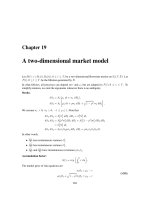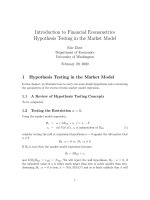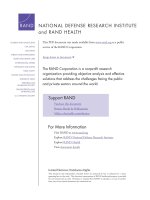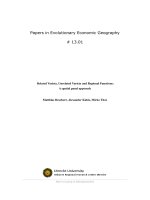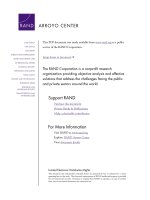Inflation linked option pricing a market model approach wtih stochastic volatility
Bạn đang xem bản rút gọn của tài liệu. Xem và tải ngay bản đầy đủ của tài liệu tại đây (1.01 MB, 70 trang )
Inflation – linked Option Pricing: a Market Model Approach with
Stochastic Volatility
LIANG LIFEI
(B.Sc. (Hons), NUS)
A THESIS SUBMITTED FOR THE DEGREE OF MASTER OF SCIENCE
DEPARTMENT OF MATHEMATICS
NATIONAL UNIVERSITY OF SINGAPORE
2010
i
Acknowledgements
I have been interested in the area of financial modeling for the whole of my undergraduate and
graduate years, and I am very glad that this thesis has given me the chance to gain more
modeling knowledge of inflation-linked derivatives. I would like to extend my deepest
appreciation to the following people whose support has made my research project an enjoyable
experience.
First and foremost, I am very lucky to be a student of my supervisor Prof. Xia Jianming and cosupervisor Dr. Oliver Chen. They have provided me with valuable suggestions and
encouragement for the research, and their insights have inspired me and broadened my
knowledge in this field. I am very grateful to have them as my supervisors.
I would like to thank Mr. Pierre Lalanne as well as inflation trading desk of UBS who have
answered my queries with practical knowledge and helped me generously throughout the thesis.
I would also like to thank Mr. Zhang Haibo and Ms. Zhang Chi from Department of Chemical
and Biomolecular Engineering, NUS, whose expertise in optimization has helped me greatly.
Finally, I would like to thank Department of Mathematics and National University of Singapore
for providing necessary resources and financial support; my friends for their cheerful company
and my parents who have always been supportive throughout the years.
ii
Table of Contents
Acknowledgements ........................................................................................................................ i
Summary ....................................................................................................................................... iv
List of Symbols .............................................................................................................................. 1
List of Tables ................................................................................................................................. 3
List of Figures ................................................................................................................................ 5
1.
Introduction ........................................................................................................................... 6
2.
Two Factor Stochastic Volatility LMM Model ................................................................. 10
2.1.
Forward CPI and Forward Risk Neutral Measure .......................................................... 10
2.2.
Two Factor Model and Derivation of Pricing Formula.................................................. 11
2.3.
Implementation Issues .................................................................................................... 15
3.
Hedging of Inflation - Linked Options .............................................................................. 17
4.
Convexity Adjustment ......................................................................................................... 20
5.
Calibration ........................................................................................................................... 25
6.
5.1.
Parameterization ............................................................................................................. 26
5.2.
Interpolation – Based Calibration .................................................................................. 28
5.3.
Non – Interpolation – Based Calibration........................................................................ 38
Conclusions........................................................................................................................... 44
Bibliography ................................................................................................................................ 46
Appendices ................................................................................................................................... 49
iii
Appendix I Derivation of YoY caplet price under one factor stochastic volatility................... 49
Appendix II Riccati equation .................................................................................................... 59
Appendix III Structural deficiency of one factor model ........................................................... 60
Appendix IV Interpolation based on flat volatilities ................................................................. 61
iv
Summary
Inflation-linked derivatives‟ modeling is a relatively new branch in financial modeling.
Originally it was adapted from interest rate models; but attention is currently turning to market
model. In this thesis, we extend stochastic volatility market model to two-factor setting. The
analysis in this thesis shows that two-factor model offers more profound structure and greater
flexibility of fitting volatility surface while retaining the tractability of one-factor model.
We then apply the two-factor model to two related issues. Hedging analysis is conducted from a
new perspective where zero-coupon (ZC) options are used to hedge year-on-year (YoY) options.
This can be of great practical interest as it leverages on a complicated trading book and saves on
transaction cost. Convexity adjustment is also approximated under the model. Furthermore, we
have illustrated in detail how it can be captured via concrete trading activities.
The new two-factor model regime and broader scope which aims to calibrate both ZC and YoY
options with one model, call for new calibration procedures. In this thesis, two approaches have
been proposed.
Firstly, we devise an interpolation scheme that yields a market consistent interpolation. A
calibration against these interpolated prices can reveal mispricing and, thus, arbitrage
opportunities between the two options markets. However, a more thorough analysis is necessary
to determine if a misprice can really constitute an arbitrage opportunity.
Secondly, to mitigate the arbitrary nature of interpolation, we propose a non-interpolation-based
calibration scheme. In this approach, only market-quoted prices are inputs of calibration. ZC and
YoY option prices are weighted differently to reflect their respective market liquidity and bidoffer spreads.
v
With this thesis, we fulfilled the aim to build a comprehensive framework under which an
inflation-linked option pricing model can be calibrated and applied.
1
List of Symbols
The Consumer Price Index at time
- forward CPI at time t
Swap break-even of a
zero – coupon inflation-linked swap
Price at time t of nominal zero coupon bond with maturity
Short rate at time s
Period between
and
Forward rate between times
and
as seen at time t
Volatility of
The j th factor loading of
,j=1&2
The j th factor loading of
and 0 afterwards
extended by time, i.e. it is equal to
The j th common variance process of forward CPIs, j = 1 & 2
Mean reversion of
Long-term variance of
Volatility of variance
Brownian motion associated to
of
Brownian motion that drives
Brownian motion that drives
Correlation between the j th factor of
Correlation between
and
and
, i.e.
when
2
Correlation between
C
and the j th factor of
, i.e.
YoY caplet price
Price of ZC caplet with maturity at
Weight assigned to errors of ZC caps in non-interpolation-based calibration
Weight assigned to errors of YoY caps in non-interpolation-based calibration
3
List of Tables
Table 4.1
Dynamic hedging when
moves by 1.
23
Table 4.2
Dynamic hedging when
by 1.
moves up (above) and down (below)
24
Table 5.2.1
EUR HICP ZC Cap prices, with maturities from 1yr to 10 yr and
strikes from1% to 5%. Highlighted are market prices and others
prices are interpolated.
31
Table 5.2.2
EUR HICP ZC Cap implied volatilities, with maturities from 1yr to
10 yr and strikes from1% to 5%.
31
Table 5.2.3
EUR HICP YoY Cap spot vol, with maturities from 1yr to 10 yr and
strikes from1% to 5%.
32
Table 5.2.4
EUR HICP YoY Cap implied correlations, with maturities from 1yr
to 9 yr and strikes from1% to 5%.
32
Table 5.2.5
EUR HICP YoY Caplet prices, with maturities from 1yr to 10 yr and
strikes from1% to 5%. New Interpolation.
33
Table 5.2.6
EUR HICP YoY Caplet prices, with maturities from 1yr to 10 yr and
strikes from1% to 5%. Old Interpolation.
33
Table 5.2.7
Model parameters of interpolation-based calibration. Left: volatility
coefficients. Center: volatility factor loadings. Right: forward CPI /
volatility correlations.
36
Table 5.2.8
Relative percentage error of ZC option prices with maturities from
1yr to 10 yr and strikes from 1% to 5%.
37
Table 5.3.1
YoY implied correlation. Above: perturbed. Below: original.
38/39
4
Table 5.3.2
Relative percentage error of YoY cap prices. Bolded are relative error 40
of extended caps.
Table 5.3.3
Relative percentage error of ZC option prices with maturities from
1yr to 10 yr and strikes from 1% to 5%.
42
Table 7.4.1
EUR HICP YoY Cap prices.
61
Table 7.4.2
EUR HICP YoY Cap flat vol. Bolded are quoted and others are
linearly interpolated.
61
Table 7.4.3
EUR HICP YoY Cap prices. Bolded are quoted and others are from
interpolated flat vols.
62
5
List of Figures
Figure 4.1
Structure of forward starting ZC swap
22
Figure 5.2.1
EUR HICP YoY Caplet spot volatility, with maturities from 1yr
to 10 yr and strikes from1% to 5%. Left: new interpolation in this
thesis; right: old interpolation (refer to figure 7.4.2 of
Appendices).
34
Figure 5.2.2
Market and calibrated YoY implied volatility with x – axis
representing the strikes (%).
35
Figure 5.2.3
Model parameters of interpolation-based calibration. Left:
. Center left:
. Center right:
. Right:
.
36
Figure 5.3.1
YoY implied correlation. Left: perturbed. Right: original.
38
Figure 5.3.2
EUR HICP YoY Caplet spot volatility. Left: perturbed; right:
original.
39
Figure 5.3.3
Model parameters of non-interpolation-based calibration. Left:
. Right:
.
41
Figure 5.3.4
Model parameters of non-interpolation-based calibration. Left:
. Center left:
. Center right:
. Right:
.
41
Figure 5.3.5
Calibrated YoY spot volatility from non-interpolation-based
calibration.
41
Figure 7.4.1
EUR HICP YoY Cap flat vol surface
62
Figure 7.4.2
EUR HICP YoY Cap resulted spot vol
63
6
1. Introduction
Inflation-linked derivatives market was born around 2002 out of hedging needs of market
makers. Currently, inflation – linked swap is the most liquid product whose volume has
increased from almost zero in 2001 to $110 billion in 2007. Trading of inflation-linked options is
also picking up gradually.
Most inflation models so far have been derived from interest rate models. Currently, the pricing
of inflation-linked options is addressed by resorting to a foreign currency analogy. In Jarrow and
Yildrim (2003), the dynamics of nominal and real rates are modeled by one-factor Gaussian
process in the framework proposed in Heath, Jarrow and Morton (1992), or the HJM framework.
Inflation is then interpreted as the exchange rate between the nominal and the real economies.
However, this model suffers two major drawbacks. Firstly, it is based on the market nonobservable of real interest rate. Secondly, it generates volatility skew at the expense of over –
parameterization as remarked in Ungari (2008).
As such, alternative approaches are gaining popularity. For example, Kazziha (1999), Belgrade
et al (2004) and Mercurio (2005) considered a market model in which the underlying variables
are forward CPIs evolving as driftless geometric Brownian motions. Mercurio and Moreni
(2005) took one step further to incorporate a mean – reverting stochastic volatility process to the
forward CPIs while Mercurio and Moreni (2010) built a more complete model with SABR
stochastic volatility process. Details of SABR model can be found in Hagan (2002).
In Liang (2010), a variation of Mercurio and Moreni (2005) model is built. All forward CPIs are
assumed to share one common volatility process - differentiated only by respective factor
loadings. The model is then implemented and calibrated with a boot-strapping algorithm. As
7
explained in Liang (2010) and presented again in Appendix III of this thesis, the effect of the
factor loading of stochastic volatility on volatility surface is relatively limited, the model has
encountered structural difficulty in generating both skew and smile configurations in one
volatility surface. Moreover, we note that inflation - linked zero – coupon option resembles an
equity vanilla option while YoY option is nothing but a series of forward starting options. In
Bergomi (2004) and Fonseca, Grasselli and Tebaldi (2008), it is well explained that there is a
structural limitation which prevents one – factor stochastic volatility models to price consistently
forward starting options with vanilla options.
This thesis corrects the original model deficiency encountered in Liang (2010) and documented
in other literatures detailed above and addresses related issues such as hedging, convexity
adjustment and calibration. As a whole, we strive to build a comprehensive framework under
which an inflation-linked pricing model can be calibrated and applied.
Works on multi – factor stochastic volatility model, such as Bates (2000) and Christoffersen
(2007) have inspired us to extend the model in Liang (2010) to two-factor setting. Our
calibration shows that one factor can have relatively fast mean-reversion to determine short-run
variance while the other can have relatively slow mean-reversion to determine long-run variance.
Despite the seemingly straight-forward extension from one to two-factor setting, it has
significant implication to the calibration scheme. The boot-strapping style schemes proposed in
Liang (2010) will no longer work. Calibration taking into consideration of the global
configuration of the volatility surface is employed in this thesis. The goal of consistently pricing
YoY and ZC options further complicates the calibration. Belgrade et al. (2004) attempted to
address this consistency, though their model setting was too simplistic and there was no
8
calibration against actual data to measure the accuracy. We have, thus, designed a number of
schemes, which can be broadly categorized as interpolation- and non-interpolation-based
schemes.
Variable reduction is important in global optimization as we seek to avoid over-parameterization
as well as to increase the efficiency of optimization. To this end, we have adopted various
parameterization functions for different parameter sets. For example, the parameterization of
correlations is based on Mercurio and Moreni (2010) while that of the factor loadings of
volatility is as proposed in Zhu (2007).
The interpolation-based scheme conforms more to the current practice in the interest rate market.
The advantage of this scheme is that there is more control and more information extracted on the
individual caplets and floorlets. However, the parsimony of the model and the regularity of the
parameters are sacrificed, rendering the model parameters sometimes arbitrary.
The non-interpolation-based scheme does not carry out any form of interpolation and depends
solely on market-quoted prices. It improves on the deficiencies of interpolated scheme. However,
the model is sensitive to the choice of the parameterization functional.
The contributions of the thesis are the followings:
1. We extend and explore the inflation-linked stochastic volatility market model under a
multi - factor setting.
2. The hedging analysis is conducted from a new perspective that ZC options are used to
hedge YoY options – a strategy of great practical interest.
9
3. While most articles treat the subject of calibration as if it is no different from that of
interest rate models, it is actually more delicate in an inflation-linked context. This thesis
fills the gap by proposing and testing two original calibration schemes.
The thesis is structured as follows. In chapter 2, the extended two-factor stochastic volatility
model and the derived pricing formula for inflation-linked options are presented. Following that,
two related topics – hedging of inflation-linked options and convexity adjustment of YoY swaps
and options – are addressed in chapters 3 and 4 respectively. Chapter 5 deals with calibration
schemes under the new model. It starts with a review of the original calibration scheme in Liang
(2010) and a discussion on parameterization. The next subsection focuses on how to maintain the
consistency between ZC and YoY option market and proposes an alternative schemeinterpolation-based calibration scheme. Non-interpolation-based calibration scheme is presented
in the last subsection. Conclusions are presented in chapter 6. For self-contained purpose,
mathematical derivations and illustrative examples are presented in Appendices.
10
2. Two Factor Stochastic Volatility LMM Model
2.1.
Forward CPI and Forward Risk Neutral Measure
We denote
time t,
the Consumer Price Index at time
. In Kazziha (1999),
is defined as the fixed amount X to be exchanged at time
- forward CPI at
for the CPI
, so
that the swap has zero value at time t. With the description of zero coupon inflation linked swap
in Liang (2010), X at time zero is then written as
where
denotes the swap breakeven of a
zero-coupon inflation-linked swap. More
specifically, the fixed leg of the swap is priced at
which is equal to the floating leg, priced at
above denotes the price at time t of nominal zero coupon bond with maturity
Since
.
we note that the floating leg of the swap can be priced at
So we derive an important property of the forward CPI
forward measure, i.e.
that it is a martingale under
-
11
where
2.2.
defines the canonical filtration from time t.
Two Factor Model and Derivation of Pricing Formula
We present the model directly under
- forward measure.
where we denote
the factor loading of
;
forward rate between times
and
as seen at time t, ignoring day count conventions;
;
volatility of
and
where
will be defined shortly.
Before we proceed to define stochastic volatilities and the corresponding correlation structures,
we remark that
terminates as
at
. To avoid the confusion in time, we define
Then, the two forward CPIs are matched in time dimension.
12
And the stochastic process of volatility V is
The correlation structures are defined as
With j = 1 and 2, k = i and i – 1 and < , > denotes the quadratic co-variation of stochastic
processes. The technical aspect of quadratic variation can be found in Brigo and Mercurio
(2006).
And at the same time, we also have, in the nominal market,
with
By applying the same drift-freezing technique and fast Fourier transformation as in Liang (2010)
and Mercurio and Moreni (2005)1, we derive the pricing formula of YoY caplet as
1
The two articles are on one-factor setting, but the extension to two-factor setting is straight-forward as
we have shown in Appendix I.
13
where
And functions A and B above are solutions of the following general Riccati equation:
14
which take the specific form in equations below
where
And the YoY caplet can thus be evaluated by computing numerically the integral. Detailed
derivation is presented in Appendix I.
Similarly but more easily, ZC caplet can be priced as
where
We will end this section with a few remarks, which serve to deepen our understanding of the
model. A more thorough discussion can be found in Christofferson (2007).
Since
15
thus,
and
So finally, we see that
The simple calculation above shows that the effective correlation is now stochastic. By adding
one more volatility factor, the model is not only extended, but is also fundamentally changed.
The richer volatility surface configurations result not only from a mere increase of the number of
parameters, but from a more complex model structure.
2.3.
Implementation Issues
As pointed out in many articles, Heston integrals (1) and (3) involve a complex logarithm which
is inherently discontinuous. This discontinuity causes numerical integration to be difficult and
sometimes generates mispricing for long maturities, as documented in Albrecher et al. (2006). In
Liang (2010), the method proposed in Kahl and Jäckel (2006) is adopted to alleviate, if not
resolved the problem. However, it has been pointed out but left unresolved that the method is
difficult to extend to inflation – linked context. It turns out that Albrecher et al. (2006) provides a
more feasible correction for the purpose of this thesis.
16
They noted that complex root of
has two possible values. By conventions, the
principal value is used in most formulas of Heston characteristic function and is also returned by
most software packages. But using the principal values causes a branch cut – a curve in the
complex across which a function is discontinuous. Function A in equation (2) above jumps
discontinuously each time the imaginary part of the argument of the logarithm crosses the
negative real axis. They followed by proving that choosing the second value of
would circumvent the problem. Contrary to Liang (2010), we adopt this
proposition for both YoY and ZC pricing formulas throughout the thesis.
Another benefit of this remedy is that the numerical integration becomes much more stable, in
the sense that it yields valid value for much wider range of parameters. Consequently, the
calibration process improves in efficiency. This is because when optimization algorithm scans
through the cost function across a range of parameter sets, many more points contain a valid
numerical value.
17
3. Hedging of Inflation - Linked Options
Although fast Fourier transformation enables us to derive a closed formula to price inflationlinked options, this approach yields little information on hedging strategies. In this section, we
apply Itô‟s lemma to obtain a hedging strategy.
According to conventional wisdom, we normally dynamically hedge a derivative with its
underlying. In the present context, a YoY option should, thus, be hedged via a combination of
ZC swaps. However, in order to leverage on the synergy of a bank‟s trading book, which
contains both YoY and ZC options, we aim to hedge YoY options with ZC options. In this way,
we save transaction cost compared to usual strategies.
be the price of a YoY caplet, then by Itô‟s lemma,
Let
where
denotes as before the quadratic co – variation of stochastic processes and we
abbreviate further
as
We propose a hedging portfolio, consisting of ZC swaps as well as ZC options with maturities of
and
, i.e.
18
where
is the date of the reference CPI fixing, which is assumed to be identical for both swaps and
caps for simplification purpose;
and
denote ZC caps with maturities of
and
respectively;
represents ZC swap with reference CPI fixing at
.
Again, by Itô‟s lemma, each component satisfies the following:
Putting everything together, we have
Thus, in order to hedge all the risks, we must have
and maturity at
